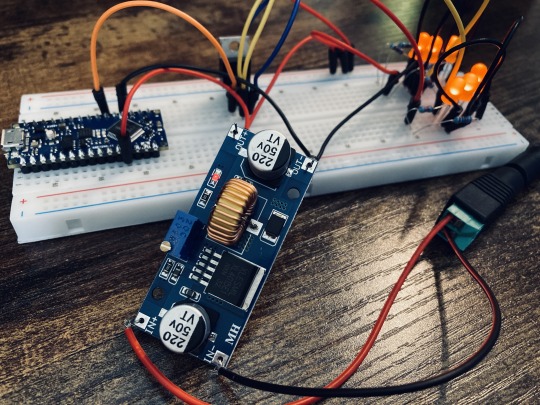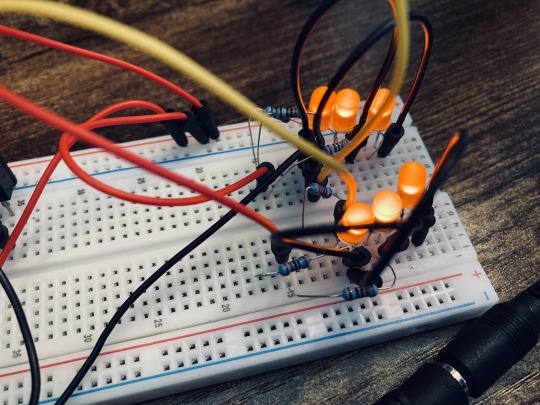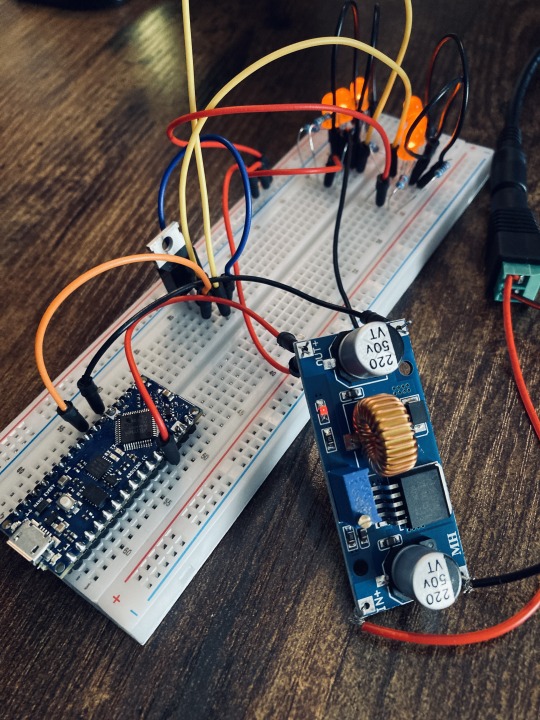#demandunit
Explore tagged Tumblr posts
Text
🟠 Push for Signal
A new threshold wired in.
The demand unit now rests on the lowest shelf — grounded, patient, waiting. The amber beacon above pulses in response, wired through the frame like a nervous system. Press the button and hold: eight LEDs rise in a slow crescendo, a countdown to sensory overload.
🔊 Then the warning blare. 🟠 Then the light.
It’s a simple loop. But it captures something deeper — the daily negotiation of noise and meaning. A hearing world demands attention. My system delays it. The delay becomes survival.
This unit is wired to the same nervous energy that built Ezra. The same push for signal I feel each day — As a deaf creator navigating clatter, captions, contradiction.
You could call it a self-portrait in wires. Or maybe just a wake-up call.
🧠💡
#signal#noise#sensoryoverload#demandunit#beacon#deaftech#glitchlab#theinterpreter#ezra#arduino#pushforsignal#liminality#processzine#analoguefuture#captionthis
1 note
·
View note
Text
"Push Button, Wait for Signal" — Demand Unit v1.0 Complete
The demand unit build is now fully enclosed, wired, and operational — a clean, compact execution of a deliberately analog interface.
Housed inside a recycled industrial enclosure, 8 LEDs form a circular halo around the button faceplate, smoothly pulsing through a crescendo before triggering an internal pedestrian speaker tone and an external rotating amber beacon. All timing is Arduino-controlled with precise 10-second cycles, and the unit resets automatically after each call.
🔧 Internally:
Arduino Nano Every on mini breadboard
Buck converter stepping 12V down to 5V logic
2 x IRLZ44N MOSFETs handle LEDs + beacon/speaker switching
Mounted barrel jacks + USB passthrough for clean external ports
📦 Externally:
Barrel input for 12V power
Beacon cable routed via rear port
USB cable fed out back for code updates without disassembly
Sound ON recommended 🎧 — you’ll hear the internal speaker's familiar pedestrian signal chirp, followed by the soft mechanical whir of the beacon's rotating mirror as the system peaks. An audible and visual interplay of anticipation, confirmation, reset.
Everything’s mounted, glued, and reinforced inside. The result? A glitch-era accessibility totem — part artefact, part interface, part listening machine.
#processzine#signalnoise#glitchlab#arduino#interactiondesign#pedestriandevice#industrialdesign#liminaltech#deafprocess#breadboardcore#demandunit#postutility
0 notes
Text
🟠 push button / wait for signal (Demand Unit v0.3 – LED crescendo test)
A first successful run of the demand unit build — the momentary push of the pedestrian button triggers a slow-burn crescendo: eight amber LEDs pulse in unison, gradually quickening until they become steady. A visual signal mimicking sound.
Inspired in part by the Black Mirror startup tones — where a single beep accelerates into an unbroken alarm — this version translates sound into light, delay into embodiment. You don’t hear the escalation — you feel it. It’s not a tone, but a tension.
This is designed to simulate what it feels like to process sound with auditory processing disorder, deafness, or misfiring neural signal — a delayed recognition, a steadying pulse, then overload.
The full circuit runs from an Arduino Nano Every, via MOSFET, and powered from a 12V PSU (buck-converted to 5V for logic). The beacon and speaker activation sequence will come next.
📍Prototype includes: – Authentic pedestrian demand unit button – Slow-pulse LED sequence (with crescendo logic) – MOSFET control chain via D3 – Internal pull-up detection of button press – Future: beacon and speaker activation, full reset loop
🧠 It’s all part of the SIGNAL // NOISE project: visualising the act of listening, captioning what cannot be heard.

#processzine#signalnoise#arduino#glitchlab#blackmirror#deafdesign#auditoryprocessing#ledart#soundtoimage#liminaltech#demandunit#captionthis#ezra#cochlearimplant#sounddesign#emergentinterface
0 notes
Text



🟠 Progress Log // Demand Unit Prototype [LED Array Test v0.3] “What begins as a flicker becomes a pattern.”
After some wrangling, wire-shuffling, and visual logic puzzles, I’ve managed to get multiple Lumetheus 5mm amber LEDs running in parallel, each with its own resistor, all powered by a buck-converted 12V supply stepped down to ~5V. The middle pin of the IRLZ44N MOSFET acts as a shared ground switch — triggered by the Arduino Nano Every.
What tripped me up initially: +5V rail behaviour and how to distribute it effectively. It wasn’t until I moved the main power jumper to the actual rail and fed from there that it clicked — from there I simply branched off into each LED’s anode, keeping all cathodes tied back through resistors to the MOSFET drain. Classic parallel design.
This method means:
Each LED draws independently but is synchronised by the control signal.
I can scale brightness and quantity without overloading a single path.
It’s modular and visual — exactly the type of architecture the Interpreter demands.
💡Photos:
The first successful “6 LED glow” — dim but perfectly uniform.
Buck converter in frame, feeding clean 5V into the rail.
Breadboard overview showing Arduino Nano, MOSFET, and LED array bridged across multiple rows.
🛠 Next steps (waiting on parts): • Swap in fresh Nano Every (suspect current one may be flaky) • Measure actual output voltage with multimeter • Begin scripting LED “presence cycle” (fade, flicker, hold) to reflect signal/limbo/stasis themes • Mount LEDs into the physical demand unit shell alongside the mechanical push button and beacon
#processzine#glitchlab#arduino#signalnoise#demandunit#ezra#ledarray#cochlearcircuitry#apdmetaphor#presencepatterns#breadboardrituals#interpretationloop
1 note
·
View note